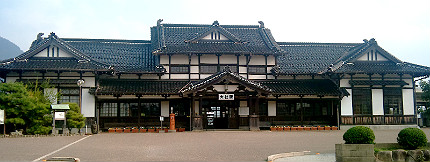quick look on Japanese history (5) Meiji,Taisho period
(11) Meiji period(1868-1912)
Toward the end of Edo period, lots of American and European warships came to Japan frequently and demanded the Shogunate to allow free trade with the background of military superiority. During 265 years‘s peaceful time, Japan neglected to keep and develop military ability and consequently was not able to resist against foreign military powers. Tokugawa Shogunate was forced to contract the unequal treaty of Amity and Commerce with U.S,A , then European nations.
Relatively smooth and peaceful transition of power
The Tokugawa who failed to keep the unity of the nation and dignified independence returned the power to the Emperor. Enterprising nobles and young leaders from provincial domains gathered and opened Meiji new government. During the transition from Tokugawa to Meiji, there were lots of disputes and conflicts, however death toll were around 30 thousands only, which were rather small in comparison with 2 millions of French Revolution.
Meiji government deprived hereditary provincial lords of traditional privileges by abolishing provincial domains. The government in succession deprived Samurais of their privileges. Meiji revolution was done mainly by provincial lords and Samurais who gave up their traditional privileges by themselves and was completely different from European revolutions which lower and middle classes took the power out of upper class.
In the first year of Meiji period (1968), Meiji emperor announced Oath in Five Articles which addressed to whole nation to build modern nation through democratic way by all classes cooperation and contribution.
Quick modernization
The first public silk factory built in1872 (tomioka seishijo)
The government tried hard to introduce European social system and industrial technology so that Japan could catch up with world great power and abolish the above unfavorable treaty.
At the beginning of Meiji period, Japan wished to form an alliance with neighboring China and Korea against European colonialism. However internal situations of both nations were so confused and Japan turned the policy to struggle with Russian strategy of pushing southward by herself. Japan won the war against China in 1894-1895 to free Korea from Chinese control. Then Japan defeated Russia in 1904-1905 which was first victory of Asian nation against any European nation in modern time war. Japan was ranked among first class great powers and became a twinkling rising star among Asian or colored people. The Anglo Japanese Alliance was signed in 1902、while Japan successfully got rid of extraterritorial rights from Western nations in 1899 and regained tariff autonomy in 1911.
Japan annexed Korea in 1910 to prepare Russian pushing and European imperialism such as Britain to India and Burma, France to Vietnam, Holland to Indonesia, America to Philippine and so on.
(12) Taisho period (1912-1926)
From Meiji period onward, Japan set the rule as one Emperor one period. Since Taisho Emperor died young, Taisho period was as short as 14 years.
After the severe struggle to win the honorable status of the first class nation, Japan took a short rest during Taisho period. This period is called as Taisho democracy. Democratic mood prevailed among political fields and arts and literatures.
Conflict between Japan and U.S.A. emerged
However, the world war first broke out in 1914 and Japan was gradually drawn into international tension and conflicts.
Toward the end of 19th century, U.S.A. advanced Pacific ocean by controlling Hawaii, Midway, Philippine and so on, while Japan successfully won two wars as above. Two new great powers began to collide with each other in Pacific ocean and Mainland China.
U.S.A. set the Japanese Exclusion Act in 1924 to eliminate Japanese immigrants unevenly.
The Anglo Japanese Alliance ended in 1923 and was never signed again.

Railway station built in Taisho period (shimattane.blog)







